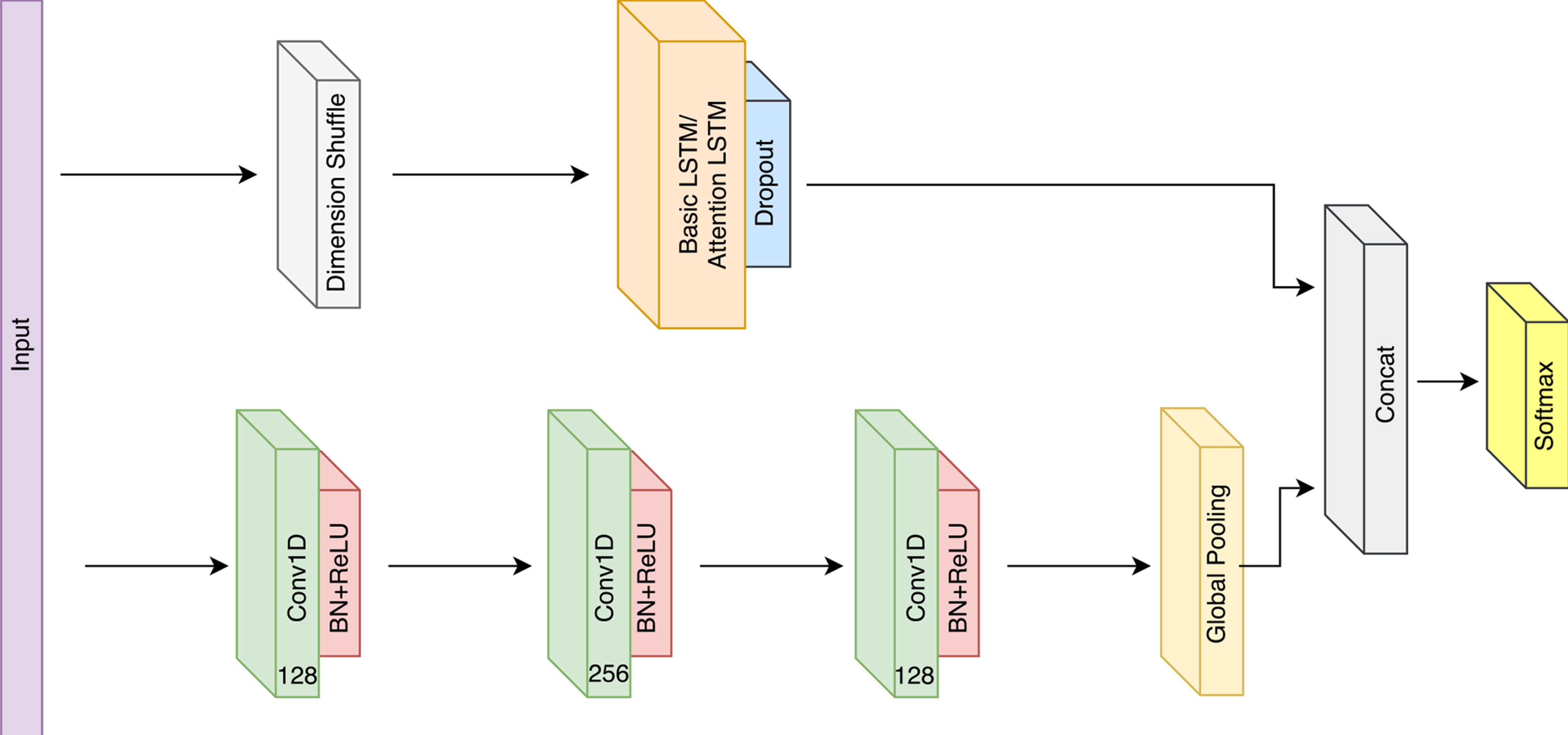Implementing LSTM-FCN in pytorch - Part I
25 Nov 2018 by dzlabThe follwoing article implements Multivariate LSTM-FCN architecture in pytorch. For a review of other algorithms that can be used in Timeseries classification check my previous review article.
Network Architecture

LSTM block
The LSTM block is composed mainly of a LSTM (alternatively Attention LSTM) layer, followed by a Dropout layer.
A shuffle layer is used at the begning of this block in case the number of time steps N (sequence length of the LSTM layer), is greater than the number of variables M.
This tricks improves the efficiency as the LSTM layer since it will require M time steps to process N variables, instead of N time steps to process M variables each timestep in case no shuffle is applied.
In pytorch, the LSRM block looks like the following:
class BlockLSTM(nn.Module):
def __init__(self, time_steps, num_variables, lstm_hs=256, dropout=0.8, attention=False):
super().__init__()
self.lstm = nn.LSTM(input_size=time_steps, hidden_size=lstm_hs, num_layers=num_variables)
self.dropout = nn.Dropout(p=dropout)
def forward(self, x):
# input is of the form (batch_size, num_variables, time_steps), e.g. (128, 1, 512)
x = torch.transpose(x, 0, 1)
# lstm layer is of the form (num_variables, batch_size, time_steps)
x = self.lstm(x)
# dropout layer input shape:
y = self.dropout(x)
# output shape is of the form ()
return yFCN block
The core component of fully convolutional block is a convolutional block that contains:
- Convolutional layer with filter size of 128 or 256.
- Batch normalization layer with a momentum of 0.99 and epsilon of 0.001.
- A ReLU activation at the end of the block.
- An optional Squeeze and Excite block.
In pytorch, the a convolutional block looks like the following:
class BlockFCNConv(nn.Module):
def __init__(self, in_channel=1, out_channel=128, kernel_size=8, momentum=0.99, epsilon=0.001, squeeze=False):
super().__init__()
self.conv = nn.Conv1d(in_channel, out_channel, kernel_size=kernel_size)
self.batch_norm = nn.BatchNorm1d(num_features=out_channel, eps=epsilon, momentum=momentum)
self.relu = nn.ReLU()
def forward(self, x):
# input (batch_size, num_variables, time_steps), e.g. (128, 1, 512)
x = self.conv(x)
# input (batch_size, out_channel, L_out)
x = self.batch_norm(x)
# same shape as input
y = self.relu(x)
return yThe fully convolutional block contains three of these convolutional blocks, used as a feature extractor. Then it uses a global average pooling layer to generate channel-wise statistics.
In pytorch, a FCN block would look like:
class BlockFCN(nn.Module):
def __init__(self, time_steps, channels=[1, 128, 256, 128], kernels=[8, 5, 3], mom=0.99, eps=0.001):
super().__init__()
self.conv1 = BlockFCNConv(channels[0], channels[1], kernels[0], momentum=mom, epsilon=eps, squeeze=True)
self.conv2 = BlockFCNConv(channels[1], channels[2], kernels[1], momentum=mom, epsilon=eps, squeeze=True)
self.conv3 = BlockFCNConv(channels[2], channels[3], kernels[2], momentum=mom, epsilon=eps)
output_size = time_steps - sum(kernels) + len(kernels)
self.global_pooling = nn.AvgPool1d(kernel_size=output_size)
def forward(self, x):
x = self.conv1(x)
x = self.conv2(x)
x = self.conv3(x)
# apply Global Average Pooling 1D
y = self.global_pooling(x)
return yLSTM-FCN
Finally, putting together the previous blocks to construct the LSTM-FCN architecture by concatenating the out of the blocks and passing it throgh a softmax activation to generate the final output.
class LSTMFCN(nn.Module):
def __init__(self, time_steps, num_variables):
super().__init__()
self.lstm_block = BlockLSTM(time_steps, num_variables)
self.fcn_block = BlockFCN(time_steps)
self.softmax = nn.Softmax()
def forward(self, x):
# input is (batch_size, time_steps), it has to be (batch_size, 1, time_steps)
x = x.unsqueeze(1)
# pass input through LSTM block
x1 = self.lstm_block(x)
# pass input through FCN block
x2 = self.fcn_block(x)
# concatenate blocks output
x = torch.cat([x1, x2], 1)
# pass through Softmax activation
y = self.softmax(x)Training
Part II discusses the training setup of the LSTM-FCN architecture using different Datasets.